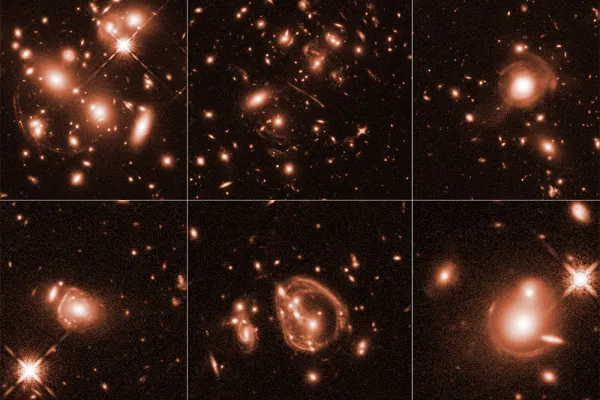Cosmic Views: James Lowenthal’s Research on Rare Bright Galaxies
Research & Inquiry

Published July 18, 2017
When astronomy professor James Lowenthal and his research colleagues began reviewing new images from the Hubble Space Telescope earlier this year, they couldn’t believe their eyes.
Calculations they’d made helped NASA’s telescope capture images of some of the brightest galaxies in the universe—rare infrared views that could advance scientific knowledge about the origins of massive galaxies.
The images captured other people’s attention, too: When they were unveiled at the American Astronomical Society’s annual conference a few weeks ago, the photos made national news.
 “We’ve hit the jackpot,” Lowenthal said, “We now have new views of these rare galaxies that go back close to 12 billon years—about 90 percent of the way to the Big Bang.”
“We’ve hit the jackpot,” Lowenthal said, “We now have new views of these rare galaxies that go back close to 12 billon years—about 90 percent of the way to the Big Bang.”
The new images of 22 luminous galaxies, with striking features such as rings and arcs, were made possible by a light-bending effect known as gravitational lensing.
The lensing—which Lowenthal likens to a “cosmic magnifying glass”—occurs when the gravity of a massive galaxy or cluster of galaxies magnifies the light of more distant background sources.
Here’s what else Lowenthal had to say about the Hubble images that he and his colleagues at the University of Massachusetts Amherst and Mexico’s National Institute of Astrophysics, Optics and Electronics. are studying, and how gravitational lensing has shaped his own research on the skies.
What is gravitational lensing, and why is it important to astronomy?
“Einstein predicted more than 100 years ago that massive objects will cause light rays to bend, and the work of astronomers since then has confirmed his theory. In the late 1980s and ’90s, we started taking pictures of clusters of galaxies— masses that are a thousand trillion times the mass of the sun. As we’ve looked in the direction of those clusters, we’ve seen funny shapes. To make an analogy: it’s like sitting in a fancy restaurant with a candle on your table. When you look at the candle through a wine glass, it takes on funny shapes. The bending of the light can provide new information about both the foreground source that’s doing the lensing—the wine glass—and the background source whose image is being distorted.
What is so unusual about the bright galaxies you are now able to see?
“First of all, they are rare—there are only a few dozen of them in the universe. They are also prodigious producers of stars. In the Milky Way, there are perhaps two new stars being produced per year. But these very bright starburst galaxies produce tens of thousands of stars per year. We know that star formation happens in dusty clouds where there is lots of gas present. We’re trying to see what has created these ultra-bright galaxies, what powers them and allows them to be furiously churning gas into stars. Is it a collision of two massive spiral galaxies, a flood of gas—or something else entirely?”
Do these new telescope images upend any conventional wisdom about the cosmos?
“We don’t know that yet. We’re just starting to wrap our minds around the implications of what we’re seeing. One of the great benefits of this new data set of gravitational lenses is that they act like a natural cosmic magnifying glass. The lensing makes the galaxies appear brighter, and it makes them appear larger so we can see smaller details. The hard part is that we have to unscramble what we’re seeing through the light-bending effect. We have to carefully construct computer models of the lenses themselves— dissect these images for size, shape and color—before we can answer questions about how these galaxies were formed and how they are powered.”
How do you gain access to images from the Hubble Telescope?
“We were fortunate to be awarded time on the telescope. We have proprietary use of the images it collects for us for 12 months, after which time they are released to the public. We’re about two thirds of the way through our sample now. Every couple of weeks, I’ll get an email saying, ‘We are looking at Target #3,’ for example. When I started downloading these images, they were just spectacular. We’ve been sharing them with everyone we know!”
What’s most important to know about this research, and what are your next steps?
“What I find so cool is that we have a new view of the most extreme cases of bright, star-forming galaxies in the universe. We can’t see these ultra-bright galaxies by just pointing randomly at the sky. If we took away the gravitational lensing and asked, ‘Where are the brightest galaxies?’ we’d have a different list. The lensing provides two important benefits: It makes the galaxies appear brighter, and it makes them appear larger so we can see smaller details. For me personally, seeing these images has meant a change of mindset. I didn’t have as intuitive a sense before that almost every one of these galaxies is gravitationally lensed. Bridging the gap between the study of gravitational lensing and that of distant galaxies will hopefully help us better understand the process of galaxy formation.”
NASA space telescope image of six of the brightest galaxies.